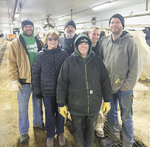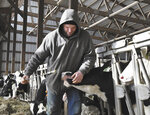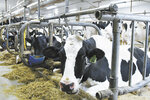


How many times a day do you milk, and what is your current herd average, butterfat and protein? We milk twice a day at 7 a.m. and 7 p.m. Our current herd average is 31,135 pounds, and our butterfat and protein are 3.3% and 4.4%, respectively.
Describe your housing and milking facility. We have a tiestall barn. We just switched to bedding with shavings. We put this on top of waterbeds and pasture mats, which we have had for a long time. We graded the gutter about a month ago. We milk with six units in the tiestall.
Who is part of your farm team, and what are their roles? My older brother, Ryan, works with the crops mostly. My dad does the feeding. My wife, Heather, milks and feeds calves as well as other needed tasks. My step-son, Greg Crumb, helps us with everything. He milks, feeds calves and makes it possible to get chores done when one of us wants to leave. I work on everything in general. I help milk, I am in charge of herd health, and I will mix feed when my dad is gone.
What is your herd health program? We preg check and ultrasound once a month. We give our cows Bovi-Shield 50 days after calving. At dry off, we give our cows Alpha-7, Endovac and SRP. Calves are tubed a gallon of frozen colostrum at birth. At weaning, they are given CORID for five days. Calves are given Inforce or Nasalgen when I move them from the hutches into the group pens.
What does your dry cow and transition program consist of? We dry off our cows for 60 days using Spectramast and ORBESEAL. I should go back to Quartermaster, but I don’t like the slaughter withhold if you have an incident with a cow aborting. Once they are dried off, they go into a pen with the pregnant heifers with a loose housing cornstalk bedding pack. Their ration is corn silage, straw and baleage. They stay there until about three weeks pre-calving, and then, I have a pre-fresh pen I put them in. After calving, the cows return to the tie stalls, but heifers are put in a pen at the end of the barn for a week or two until I have a strap on them and/or there is room in the stalls.
What is the composition of your ration, and how has that changed in recent years? Our ration has powdered corn, cottonseed, soybean meal, molasses, brown midrib corn silage, haylage, baleage and barlage. I normally run in the range of 22 pounds of dry matter corn silage. I started putting in molasses in about two years ago. I probably started doing baleage two or three years ago. I like the baleage because you have more flexibility. I would not do it, however, if I didn’t have a crop cutter and the baler.
Tell us about the forages you plant and detail your harvest strategies. We harvest all our forage ourselves because I do not like to have to wait for the custom harvesters. My brother and I farm about 450 acres rented from our dad and other farmers. I usually have 50-55 acres of corn silage and 80-100 acres of hay. We cut our hay at about 28 days when we start to get a little purple and are just starting to see the alfalfa bud. We cut and then merge it a day or two later. For hay, we keep the harvester full and the rest of it is made into baleage.
What is your average somatic cell count and how does that affect your production? Our somatic cell count is around 100,000. It has gone higher the more and more milk I’ve been getting. I used to be able to keep it down at the 60,000 range, but it’s been higher for the last few years. It could be because their udders are fuller or because of dirty straw. I want to see what happens with our new shavings bedding, because the barn stays cleaner.
What change has created the biggest improvement in your herd average? Heather coming to work full time on the farm has helped me be more consistent on time. Everything is probably getting done a little quicker and chores are not dragging out all day long. We also switched our ration to have better feed as well as changed the professional who helped with our ration to find someone who better fit our farm’s vision.
What technology do you use to monitor your herd? We use DHIA to track our herd, but no specific technology.
What is your breeding program, and what role does genetics play in your production level? We use ovsynch or G6G ovsynch on our entire herd. However, if we see a heat, we will also breed off of that, but it can be kind of tricky. We started using G6G ovsynch about nine months ago, and it seems like it is going to work better than ovsynch. We try to have our first service after calving at 75 days. When I was breeding sooner, I noticed that they seemed like they were milking too much when I needed to dry them up. When choosing bulls, I look for milk, components and type. I do not pay attention to productive life. I generally will not use a bull with under 1,000 pounds of milk.
List three management strategies that have helped you attain your production and component level. Having the right quality of feed and consistency of milking and feeding times.
Tell us about your farm and your plans for the dairy in the next year. I do not have plans for the year. Last year, we put in a new electricity system on the farm and solar panels. I have had a blueprint made up for putting in robots, but I am going to wait a little bit. We ship our milk to Associated Milk Producers Inc. I rent ground for what feed I will need for the cows, and my brother rents the remainder of the ground for cash crops. We rotate the ground so the crops get changed and the manure goes different places.
Comments
No comments on this item Please log in to comment by clicking here